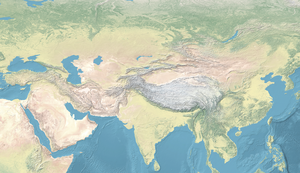
The Xia dynasty is the first dynasty in traditional Chinese historiography. According to tradition, it was established by the legendary figure Yu the Great, after Shun, the last of the Five Emperors, gave the throne to him. In traditional historiography, the Xia was succeeded by the Shang dynasty.
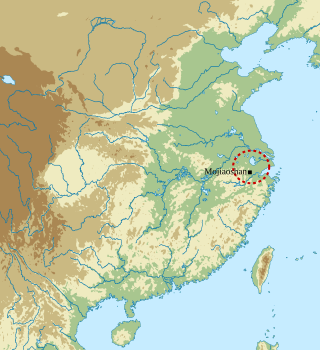
The Liangzhuculture or civilization was the last Chinese Neolithic jade culture in the Yangtze River Delta. The culture was highly stratified, as jade, silk, ivory and lacquer artifacts were found exclusively in elite burials, while pottery was more commonly found in the burial plots of poorer individuals. This division of class indicates that the Liangzhu period was an early state, symbolized by the clear distinction drawn between social classes in funeral structures. A pan-regional urban center had emerged at the Liangzhu site in northwestern Hangzhou, Zhejiang, and elite groups from this site presided over the local centers. The Liangzhu culture was extremely influential and its sphere of influence reached as far north as Shanxi and as far south as Guangdong. The primary Liangzhu site was perhaps among the oldest Neolithic sites in East Asia that would be considered a state society. The type site at Liangzhu was discovered in Yuhang County, Zhejiang and initially excavated by Shi Xingeng in 1936.

The Yangshao culture was a Neolithic culture that existed extensively along the middle reaches of the Yellow River in China from around 5000 BC to 3000 BC. The culture is named after the Yangshao site, the first excavated site of this culture, which was discovered in 1921 in Yangshao town, Mianchi County, Sanmenxia, western Henan Province by the Swedish geologist Johan Gunnar Andersson (1874–1960). The culture flourished mainly in the provinces of Henan, Shaanxi and Shanxi.
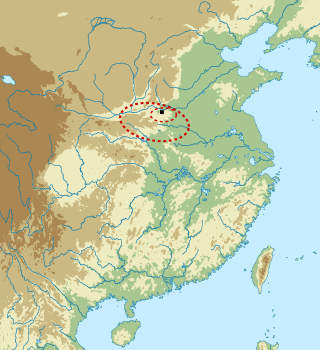
The Erlitou culture was an early Bronze Age society and archaeological culture. It existed in the Yellow River valley from approximately 1900 to 1500 BC. The culture is named after Erlitou, an archaeological site in Yanshi, Henan. It was widely spread throughout Henan and Shanxi and later appeared in Shaanxi and Hubei. Most archaeologists consider Erlitou the first state-level society in China. Chinese archaeologists generally identify the Erlitou culture as the site of the Xia dynasty, but there is no firm evidence, such as writing, to substantiate such a linkage, as the earliest evidence of Chinese writing dates to the Late Shang period.

The Dawenkou culture was a Chinese Neolithic culture primarily located in the eastern province of Shandong, but also appearing in Anhui, Henan and Jiangsu. The culture existed from 4300 to 2600 BC, and co-existed with the Yangshao culture. Turquoise, jade and ivory artefacts are commonly found at Dawenkou sites. The earliest examples of alligator drums appear at Dawenkou sites. Neolithic signs, perhaps related to subsequent scripts, such as those of the Shang dynasty, have been found on Dawenkou pottery. Additionally, the Dawenkou practiced dental ablation and cranial deformation, practices that disappeared in China by the Chinese Bronze Age.

The Majiayao culture was a group of neolithic communities who lived primarily in the upper Yellow River region in eastern Gansu, eastern Qinghai and northern Sichuan, China. The culture existed from 3300 to 2000 BC. The Majiayao culture represents the first time that the upper Yellow River region was widely occupied by agricultural communities and it is famous for its painted pottery, which is regarded as a peak of pottery manufacturing at that time.

The Qijia culture was an early Bronze Age culture distributed around the upper Yellow River region of Gansu and eastern Qinghai, China. It is regarded as one of the earliest bronze cultures in China.
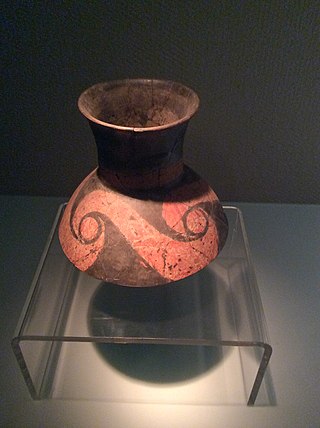
Taosi is an archaeological site in Xiangfen County, Shanxi, China. Taosi is considered to be part of the late phase of the Longshan culture in southern Shanxi, also known as the Taosi phase.

The Erligang culture is a Bronze Age urban civilization and archaeological culture in China that existed from approximately 1600 to 1400 BC. The primary site, Zhengzhou Shang City, was discovered at Erligang, within the modern city of Zhengzhou, Henan, in 1951.

The Shijiahe culture was a late Neolithic culture centered on the middle Yangtze River region in Shijiahe Town, Tianmen, Hubei Province, China. It succeeded the Qujialing culture in the same region and inherited its unique artefact of painted spindle whorls. Pottery figurines and distinct jade worked with advanced techniques were also common to the culture.
East Yi West Xia is an obsolete theory which proposes that the culture of the Chinese Shang dynasty was established by two ethnic groups; namely, that the Western part of the Shang dynasty was developed by the Xia ethnic group, and the eastern part of Shang dynasty was developed by the Yi ethnic group.
Beginning in the latter half of the 20th century, artifacts bearing markings dating to the Neolithic period have been unearthed at several archeological sites in China, mostly in the Yellow River valley. These symbols have been compared to the oracle bone script—the earliest known forms of Chinese characters, first attested c. 1200 BCE—and have been cited by some as evidence that Chinese writing has existed in some form for over six millennia. However, the Neolithic symbols have only been found in small numbers, and do not appear to go beyond pictorial techniques, as is required to obtain a true writing system representing spoken language.

Zhongyuan (Chinese: 中原; pinyin: Zhōngyuán), the Central Plain(s), also known as Zhongtu (Chinese: 中土; pinyin: Zhōngtǔ, lit. 'central land') and Zhongzhou (Chinese: 中州; pinyin: Zhōngzhōu, lit. 'central region'), commonly refers to the part of the North China Plain surrounding the lower and middle reaches of the Yellow River, centered on the region between Luoyang and Kaifeng. It has been perceived as the birthplace of the Chinese civilization. Historically, the Huaxia people viewed Zhongyuan as 'the center of the world'. Human activities in the Zhongyuan region can be traced back to the Palaeolithic period.
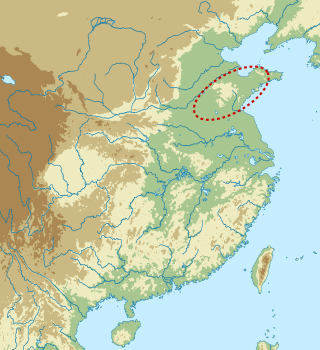
The Yueshi culture was an archaeological culture in the Shandong region of eastern China, dated from 1900 to 1500 BC. It spanned the period from the Late Neolithic to the early Bronze Age. In the Shandong area, it followed the Longshan culture period and was later replaced by the Erligang culture.
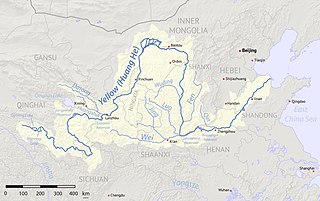
Yellow River civilization, Huanghe civilization or Huanghe Valley civilization, Hwan‐huou civilization is an ancient Chinese civilization that prospered in the middle and lower basin of the Yellow River. Agriculture was started in the flood plain of the Yellow River, and before long, through flood control and the irrigation of the Yellow River, cities were developed and political power found reinforcement. One of the "four major civilizations of the ancient world", it is often included in textbooks of East Asian history, but the idea of including only the Yellow River civilization as one of the four biggest ancient civilizations has become outdated as a result of the discovery of other early cultures in China, such as the Yangtze and Liao civilizations. The area saw the Yangshao and Longshan cultures of the Neolithic era and developed into the bronze ware culture of the Shang and Zhou dynasties.
Xinzhai is an early Bronze Age archaeological site that was found 1979 in Henan, China. It is located about 20 kilometres (12 mi) southeast of Xinmi, Zhengzhou.

The national archaeological park of China is a designation created by the State Administration of Cultural Heritage (SACH) in 2009 to preserve and present large-scale archaeological sites. National archaeological parks must have previously been designated as Major Historical and Cultural Sites Protected at the National Level, and are considered to have high historical, cultural, and academic value. They include ancient settlements, cities and towns, palaces, temples and caves, engineering and manufacturing sites, and mausoleums and cemeteries. Many parks also have on-site museums.

In 2001, the Institute of Archaeology of the Chinese Academy of Social Sciences organized a poll for China's 100 major archaeological discoveries in the 20th century. The participants included eight national-level institutions for archaeology and cultural relics, provincial-level archaeological institutes from 28 provinces, municipalities, and autonomous regions, as well as from Hong Kong, the archaeological departments of 11 major national universities, and many other scholars in Beijing. After three months and three rounds of voting, the results were announced on 29 March 2001 and were published in the journal Kaogu (Archaeology). In 2002, the Chinese Academy of Social Sciences Press published the book China's 100 Major Archaeological Discoveries in the 20th Century (二十世纪中国百项考古大发现), with more than 500 pages and 1,512 pictures.










